The primary form of traditional art I do in terms of quantity is without a doubt sketchbook doodling. I try to draw every day on the bus to and from work, which means that when I'm "on" I can get two hours of drawing a day. I don't have a 100% success rate, especially if I end up taking a nap or can't get a seat, but in comparison I'll at best do one photoshop illustration on the weekend.
Really quick, here's some thoughts on my sketchbook process, which can differ hugely from artist to artist.
•I use 11" by 14" Cachet acid free sketchbooks, which are bound in black hardcover rather than spiral. I like them because they're highly protected since they've got spines and thick covers, which means they'll be protected years from now. I like the large format (but not a hugely ridiculous format) because it's the largest format to fit in a backpack or totebag, and I won't kill people on the bus by whipping it out.
•I start by dating the inner cover. This particular sketchbook is dated "November 3, 2008...One day to the election!!!"
•I write "FRONT" on the inside cover as well. I've had numerous sketchbooks that I accidentally start from both ends.
•I then write a list of subjects on the inside cover, as a way to avoid artist's block. I find that when I don't feel like drawing, I can just look at this arbitrary list of subjects and just pick something, then force myself to draw that. Here's the current list:
---life drawing (people on the bus)
---Head (as you'll see, I do this one way too much)
---Full body
---Gestures
---MONSTERS!
---Abstract
---New Media
---Write
---Arbitrary line of action (this is a technique I developed, in which I draw any sort of squiggly line, then start attaching a person to it. Very organic!)
---RPG races
---RPG character (By "RPG races/character" I'm referring to an old favorite for inspiration of mine. I'm frequently creating characters for D&D games and such, and also have several long-term RPGs I've been designing myself. So even if I don't feel like drawing a person on the street or random fantasy crap, it feels good to draw my characters, as a way to get in character.)
•Drawing on the bus is an artistic skill in itself. Many people I know gave up on the idea, due to how the bumping, shaking, starting, stopping and embarrassing onlooking crowds discourage good art. But like anything, it just takes a lot of practice. At this point I think my bus habits have been folded into my technique, which has led to a more careful and precise, value-based method in general (albeit at the lack of gestural quality.)
•I also draw primarily using mechanical pencils. Mechanical pencils on a bus? It's like I combined the most erratic and harsh things I could! But similar to drawing on the bus, drawing with mechanical pencil just takes time. I also have a specific recommendation if you're drawing with mechanical pencil, and need a way to avoid the harsh, sharp, paper-indenting quality it's usually associated with. To draw gently with mechanical pencil, I recommend using training wheels by overextending your lead, even to around an inch long. What will happen over time is that you HAVE to start drawing softly, or else your lead breaks. over time you'll develop a soft touch, and you'll also find that you can increase or decrease your line weight by increasing or decreasing the length of your lead. Once you master these things, you've got two luxuries: first, you'll never be choosing between short, stubby old pencils and long new pencils. Second, you won't have to sharpen any more. Give it a shot, eh?
•Lastly, I mark the final page of my sketchbook with the date it was finished. The theory is to get better at filling it up faster every time.
And now for the point of this post. With the last sketchbook I finished, the whole time filling it up I kept planning to post the best stuff on this blog, and make it a regular habit. Unfortunately, by the time I finished it, there was too must stuff to put up. Do you have any idea how boring and time-consuming it is to scan stuff? Blah! I'd rather be drawing.
So with my current sketchbook, I decided to post my stuff at the halfway point, as a way to cut the workload in half. So here you are, the first half of my November 3rd sketchbook. These drawings were my favorites of this half, although I had to nix a few excellent (but work-related) sketches. Here goes!
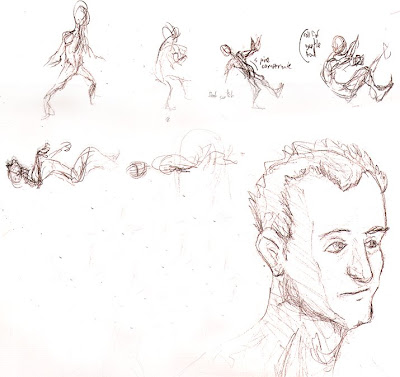
This was two things: some quick gestures for a death animation, and a decent head. One problem I've been running into is that I draw heads WAY too much. It's my favorite part of anatomy, and also the part of anatomy I'm most comfortable with. A lot of this translates into my favorite parts of 3D: facial rigging. I also recently created an in-house head generator to mass produce avatar options, and thus have been in a mood of recording different facial features.
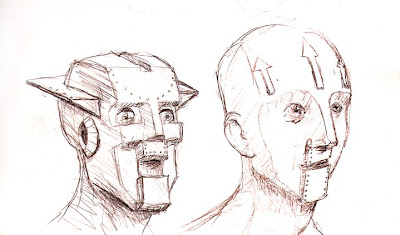
I drew these robot heads on a trip up to Bellingham, WA to help my brother move.
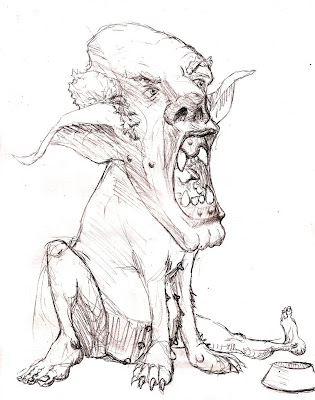
Also drawn on my way to Bellingham. The nipples were my brother's idea.
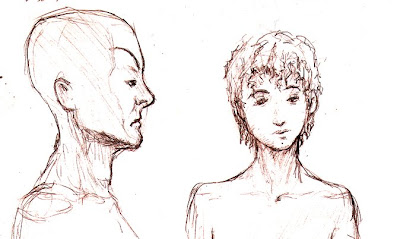
More heads, trying to get a handle on different facial features, such as "Pink Flamingos" eyebrows and a more protruding lip tubercle.
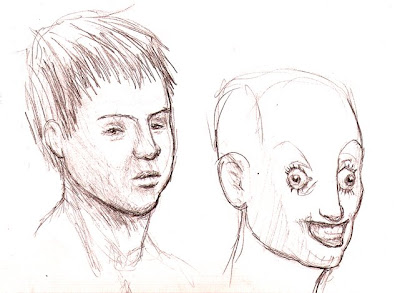
More heads, studying mongoloid features and skeletally stretched skin.
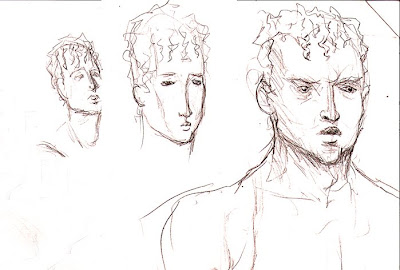
MORE heads, studying what I think of as Greek/English features: low noses, small pouty mouths, and smooth zygomatic processes.
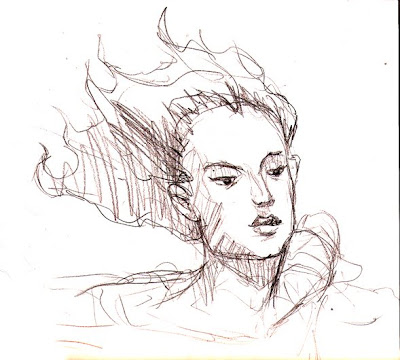
I was trying to recreate what I think of as "Waterhouse Chin," referring to the recurring muse of John William Waterhouse's paintings, most famously seen in his masterpiece "Lady of Shalott." It's partially due to the upward tilt of the head, and partially due to the square jaw offsetting otherwise feminine features.
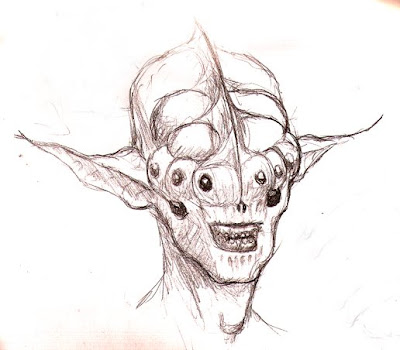
My favorite yet! I like that I retained some human qualities in this, and although I went waaay off the "realism" cliff, I think I maintained a realistic anatomical bone structure in this.
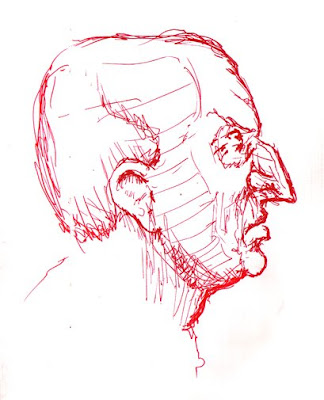
Another random head, with my most common "alternative media" of pen. Considering this was drawn from imagination, I felt happy with how realistic it turned out.
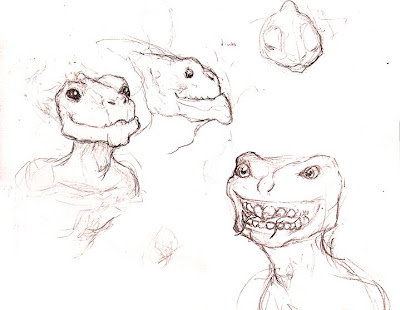
Toying around with the anatomy of an alien species...I'm going for two tongues (the main aberrational feature), broad, short heads, lizard/dinosaur features, and semi-permanent wide eyes and grins. Still needs some work, IMHO.
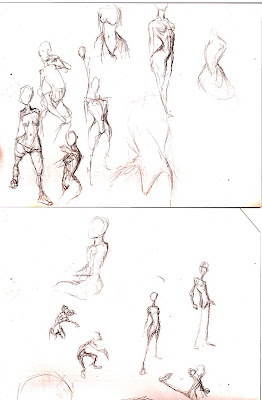
Some gestures and studies of torsos. I think I was feeling guilty about drawing nothing but heads.
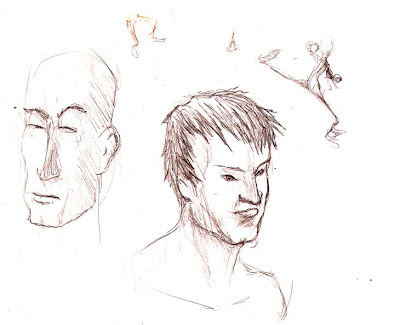
Aaaaand lastly, some more heads and a gesture drawing.
Here's hoping the second half of this sketchbook was as fun as the first.
www.oscarts.org
oscarbaechler@gmail.com



















